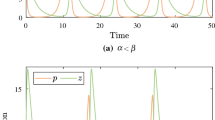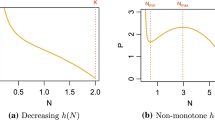Abstract
This article addresses a new dynamic optimization problem (DOP) based on the Predator-Prey (PP) relationship in nature. Indeed, a PP system involves two adversary species where the predator’s objective is to hunt the prey while the prey’s objective is to escape from its predator. By analogy to dynamic optimization, a DOP can be seen as a predation between potential solution(s) in the search space, which represents the predator, and the moving optimum, as the prey. Therefore we define the dynamic predator-prey problem (DPP) whose objective is to keep track of the moving prey, so as to minimize the distance to the optimum. To solve this problem, a dynamic approach that continuously adapts to the changing environment is required. Accordingly, we propose a new evolutionary approach based on three main techniques for DOPs, namely: multi-population scheme, random immigrants, and memory of past solutions. This hybridization of methods aims at improving the evolutionary approaches ability to deal with DOPs and to restrain as much as possible their drawbacks. Our computational experiments show that the proposed approach achieves high performance for DPP and and competes with state of the art approaches.














Similar content being viewed by others
References
Alba E, Sarasola B (2010) Measuring fitness degradation in dynamic optimization problems. In: Applications of Evolutionary Computation, Lecture Notes in Computer Science, vol 6024. Springer, Berlin, pp 572–581
Ben-Romdhane H, Alba E, Krichen S (2013) Best practices in measuring algorithm performance for dynamic optimization problems. Soft Comput 17(6):1005–1017
Blom H, Küch C, Losemann K, Schwiegelshohn C (2009) Peppa: A project for evolutionary predator prey algorithms. In: Proceedings of the 11th Annual Conference Companion on Genetic and Evolutionary Computation Conference: Late Breaking Papers, GECCO ’09, 1993–1998. ACM, New York, NY, USA
Branke J (1999) Memory enhanced evolutionary algorithms for changing optimization problems. In: Congress on Evolutionary Computation CEC99. IEEE, pp 1875–1882
Chang YH, Tomlin C, Hedrick K (2011) Biologically-inspired coordination of multiple uavs using sliding mode control. In: American Control Conference (ACC), pp 4123–4128
Chowdhury S, Moral RJ, Dulikravich GS (2008) Predator-prey evolutionary multi-objective optimization algorithm: Performance and improvements. In: 7th ASMO-UK/ISSMO International Conference on Engineering Design Optimization, 1-10, Bath, UK
Cruz C, González J, Pelta D (2011) Optimization in dynamic environments: a survey on problems, methods and measures. Soft Computing - A Fusion of Foundations. Methodol Appl 15:1427–1448
Deb K, Kalyanmoy D (2001) Multi-Objective Optimization Using Evolutionary Algorithms. Wiley, New York
Duan H, Li P, Yu Y (2015) A predator-prey particle swarm optimization approach to multiple ucav air combat modeled by dynamic game theory. Journal of Automatica Sinica IEEE/CAA 2(1):11–18
Grimme C, Lepping J (2007) Designing multi-objective variation operators using a predator-prey approach. In: Obayashi S, Deb K, Poloni C, Hiroyasu T, Murata T (eds) Evolutionary Multi-Criterion Optimization, Lecture Notes in Computer Science, vol 4403. Springer, Berlin, pp 21–35
Grimme C, Lepping J, Papaspyrou A (2008) The parallel predator-prey model: A step towards practical application. In: Parallel Problem Solving from Nature-PPSN X, Lecture Notes in Computer Science, vol 5199. Springer, Berlin, pp 681–690
Grimme C, Lepping J, Papaspyrou A (2009) Adapting to the habitat: On the integration of local search into the predator-prey model. In: Evolutionary Multi-Criterion Optimization, Lecture Notes in Computer Science, vol 5467. Springer, Berlin, pp 510–524
Gueli R (2006) Predator-prey model for discrete sensor placement. In: 8th Annual Symposium on Water Distribution Systems Analysis. Cincinnati, Ohio, pp 1–9
Jin Y, Branke J (2005) Evolutionary optimization in uncertain environmentsa survey. IEEE Trans Evol Comput 9:303–317
Kim YK, Kim JY, Kim Y (2004) A tournament-based competitive coevolutionary algorithm. Appl Intell 20(3):267–281
Laumanns M, Rudolph G, Schwefel HP (1998) A spatial predator-prey approach to multi-objective optimization: A preliminary study. In: Parallel Problem Solving from Nature - PPSN V, Lecture Notes in Computer Science, vol 1498. Springer, Berlin, pp 241–249
Li X (2003) A real-coded predator-prey genetic algorithm for multiobjective optimization. In: Evolutionary Multi-Criterion Optimization, Lecture Notes in Computer Science, vol 2632. Springer, Berlin, pp 207–221
Liu M, He J (2009) A hybrid genetic algorithm with hyper-mutation and elitist strategies for automated analog circuit design. In: Intelligent Systems and Applications, 2009. ISA 2009. International Workshop on, pp. 1–4
Morrison RW (2003) Performance measurement in dynamic environments. In: Barry AM (ed) GECCO 2003: Proceedings of the Bird of a Feather Workshops, Genetic and Evolutionary Computation Conference. AAAI, Chigaco, pp 99–102
Nebti S, Meshoul S (2009) Predator prey optimization for snake-based contour detection. Int J Intell Comput Cybern 2(2):228–242
Nguyen TT, Yang S, Branke J (2012) Evolutionary dynamic optimization: A survey of the state of the art. Swarm Evol Comput 6(0):1–24
Park T, Ryu KR (2010) A dual-population genetic algorithm for adaptive diversity control. IEEE Trans Evol Comput 14(6):865–884
Praczyk T (2014) Using augmenting modular neural networks to evolve neuro-controllers for a team of underwater vehicles. Soft Comput 18(12):2445–2460
Seoane P, Gestal M, Dorado J, Rabuñal J, Rivero D (2012) Approach of genetic algorithms with grouping into species optimized with predator-prey method for solving multimodal problems. In: Distributed Computing and Artificial Intelligence, Advances in Intelligent and Soft Computing, vol 151. Springer, Berlin, pp 689–699
Silva A, Neves A, Costa E (2002) An empirical comparison of particle swarm and predator prey optimisation. In: Artificial Intelligence and Cognitive Science, Lecture Notes in Computer Science, vol 2464. Springer, Berlin, pp 103–110
Silva A, Neves A, Costa E (2003) Sappo: A simple, adaptable, predator prey optimiser. In: Pires F, Abreu S (eds) Progress in Artificial Intelligence, Lecture Notes in Computer Science, vol 2902. Springer, Berlin, pp 59–73
Weicker K (2002) Performance measures for dynamic environments. In: Parallel Problem Solving from NaturePPSN VII. Springer, Verlag, pp 64–73
Yang S (2005) Memory-based immigrants for genetic algorithms in dynamic environments. In: Proceedings of the 7th Annual Conference on Genetic and Evolutionary Computation, GECCO ’05. ACM, pp 1115–1122
Yannakakis GN, Hallam J (2004) Evolving opponents for interesting interactive computer games. In: Proceedings of the Eighth International Conference on the Simulation of Adaptive Behavior. MIT press, Santa Monica, pp 499–508
Yannakakis GN, Hallam J (2005) A generic approach for obtaining higher entertainment in predator/prey computer games. J Game Dev 1(3):23–50
Acknowledgements
This research has been partially funded by project number 8.06/5.47.4142 in collaboration with the VSB-Technical University of Ostrava and Universidad de Málaga UMA/FEDER FC14-TIC36, programa de fortalecimiento de las capacidades de I+D+i en las universidades 2014-2015, de la Consejería e Economía, Innovación, Ciencia y Empleo, cofinanciado por el fondo europeo de desarrollo regional (FEDER). Also, partially funded by the Spanish MINECO project TIN2014-57341-R (http://moveon.lcc.uma.es).
Author information
Authors and Affiliations
Corresponding author
Rights and permissions
About this article
Cite this article
Ben-Romdhane, H., Alba, E. & Krichen, S. Towards a dynamic modeling of the predator prey problem. Appl Intell 44, 755–770 (2016). https://doi.org/10.1007/s10489-015-0727-1
Published:
Issue Date:
DOI: https://doi.org/10.1007/s10489-015-0727-1




